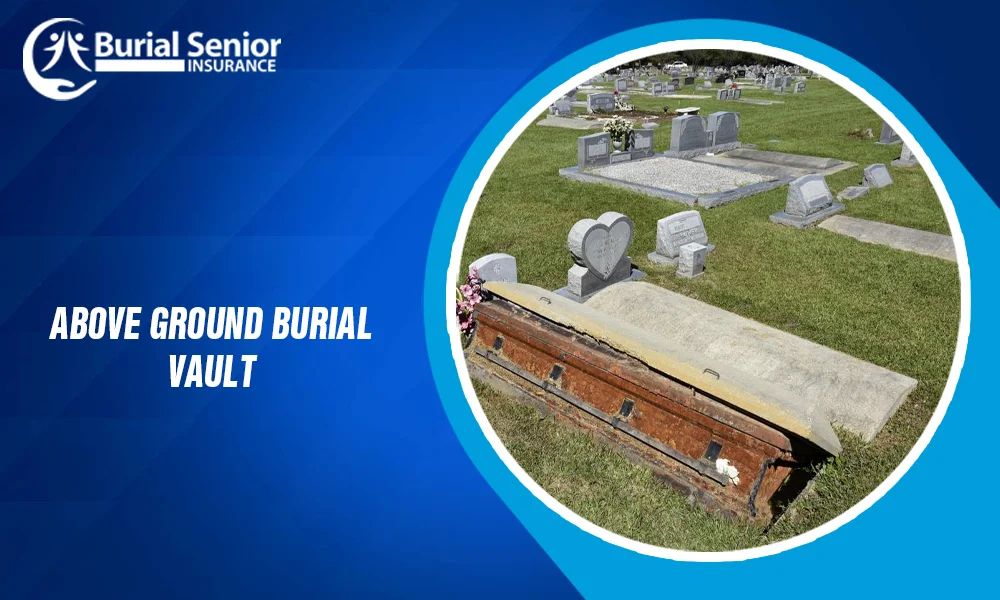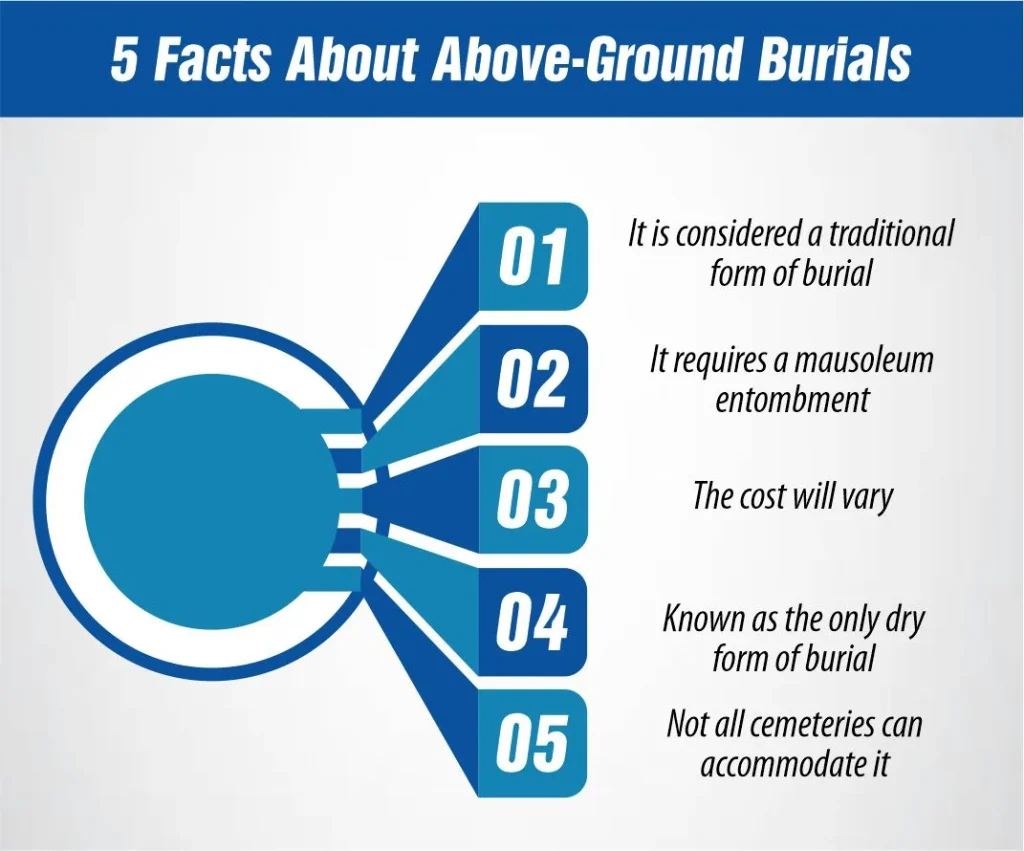Last Updated on: March 15th, 2025
Reviewed by Kyle Wilson

The final disposition of your loved one does not always necessarily need to be in the form of in-ground burial. Now, there are other options available that are more common than you may think. Above-ground burials. A question we often hear from families is, “Can you be buried above ground?” and the answer is yes, there are in fact a few different ways to have an above-ground burial. Let’s discuss the above-ground burial vaults.
Customized Options Await
Above ground burial vault, or mausoleum, is a very solid container, usually granite, that is used to hold one or more caskets for cremation niches.
Above ground burials require a mausoleum, an above ground burial vault, or crypts or niches within a building or structure.
Mausoleums are used for the above-ground placement of a casket or funeral urn.
Caskets are placed in mausoleum crypts and urns are placed in cremation niches.
Three types of above-ground interment are burial vaults, mausoleums, and columbaria. Interment is the burial of a corpse in a tomb or grave, usually with funeral rites (ceremony). Crypts can also be considered to be above-ground vaults or mausoleums, where the full or cremated body of the deceased is interred.
In the United States, a crypt, or above ground burial vault, is typically referred to as a private mausoleum, individual mausoleum (single crypt), or public (community) mausoleum in which where the intact remains or the cremated remains of the deceased are entombed in containers typically constructed with granite.
In any case, mausoleums or Above Ground Burial Vault is for above-ground placement of a casket. Caskets are placed in crypts, which are made of heavy materials like concrete (or stone, in ancient times). Crypts are built, shelf-like, from floor to ceiling and along each interior wall of the mausoleum. Some crypts are built to house two caskets, which is an option for married couples who choose to be buried above ground.
A burial vault, otherwise known as an outer burial container has the purpose of protecting the casket from the earth and stopping the ground from sinking in above the casket. The material used is concrete and manufactured at the plant right here at the Gardens at a lower price for you. The concrete burial vaults are incredibly durable and meant to last for years to come.
Burial vaults are needed to safeguard the remains within. Burial vaults are also collective in-ground burials. Heavy maintenance equipment is used over the grounds for proper care. The extra container acts like a shield and helps keep water and insects out of the actual casket. Grounds crew works tirelessly to maintain the quality of Mobile Memorial Gardens. You can rest assured that the integrity of each burial remains intact through the permanence of our structures and the maintenance of our grounds.

The final disposition of your loved one does not always necessarily need to be in the form of in-ground burial. Now, there are other options available that are more common than you may think. Above-ground burials, for example, have known origins linked to cemeteries creating an option for burials to happen above-ground due to floods. To continue to learn more about above-ground burials, here are five interesting facts.
Believe it or not, above-ground burials are just as traditional as in-ground burials. The difference? It all comes down to personal choice, but those who do choose above-ground burial will tell you it comes with many more benefits. It is considered more traditional because it is accepted across all major religions and most cultures. New Orleans, Louisiana, was nicknamed the “Cities of the Dead”, referring to the large quantity of above-ground burials that were assembled.
Above-ground burials require a mausoleum or Above Ground Burial Vault, a man-made structure within a building. Mausoleums are easily recognizable from traditional burials, as they stand out in beautifully architectural structures. Above Ground Burial Vault also come in the form of crypts that contain a casket with no vault. Cremated remains are also allowed in above-ground mausoleums, so you will not have to worry about not having this as an option. Companion units are most popular amongst larger families that desire to have a reserved section. One may then choose between a private estate or a public community-style chapel with a climate-controlled environment.
Although above-ground burials are considered an affordable option, the cost will always vary. One must first take into account the public or private preference, followed by the number of tombs, the type of shape and size, along with many other characteristics a funeral director can further explain through pre-need planning. In the end, you are getting what you pay for, so making the vast decision on the details of how you want your loved one memorialized matters.
Above-ground burials are truly the only dry form of burial and are also the cleanest. They are especially useful in high-prone flood areas as they are kept at a higher level with concrete material. During rainy or colder seasons, families can comfortably visit their loved ones under a protected roof. Lastly, maintenance requires less lawn care.
While cemeteries offer different burial options, the cemetery may not always have the space for above-ground burials. In general, above-ground tombs are efficient in-ground space. Still, because they vary in size from the ground up, it could play a role in the cemetery grounds’ limited capacity. Talking to the cemetery staff about the space will save you time and give you peace of mind.
Different methods of body deposition and entombment are available here in our gardens. From the types of containers to materials used for storing to the temperatures, there are many options for you and your loved ones. Learn about the Above Ground Burial Vault and see if this option will suit your needs best.
Funeral homes and cemeteries offer a range of options for people and families to choose the type of service that suits their desires, their budgets, and which aligns with their cultural or religious values. Similarly, cemeteries offer a range of internment options for people and families with different preferences and budgets, too. There are, of course, the traditional in-ground burial plots mentioned above. In addition, there are also other burial options, including two types for being buried above ground:
Larger cemeteries often have what’s called a mausoleum. It’s also common to find mausoleums in urban cemeteries, where space for in-ground burials may be limited. Some older, traditional cemeteries might have mausoleums, too — a hundred years ago, it was more common for wealthy families to have a family mausoleum, either in a cemetery or on their private estate.
Both mausoleums and columbariums have family options for being buried above ground, where multiple family members can be entombed in their private building. If a family cannot afford or doesn’t want a private mausoleum or columbarium, there are public versions of both as well. Some cemeteries call them “mausoleum wall crypts” in the case of public mausoleums.
In short, saying your last bye and seeing your loved ones for the last time is very hard. Above ground burial vault is very common nowadays. Choose the best option according to your needs.
While a liner won’t, a burial vault will also protect the body inside the casket from the elements. A burial vault cannot stop the decomposition process, but it can prevent water and dirt from entering the casket.
First of all, outer burial containers and burial vaults are not required by state or federal law. They are required by most cemetery rules and regulations. Cemeteries want a casket placed in an outer burial container or burial vault to prevent the ground from sinking in above the casket.
Senior Writer & Licensed Life Insurance Agent
Iqra is a dynamic and insightful senior writer with a passion for life insurance and financial planning. With over 8 years of hands-on experience in the insurance industry, Iqra has earned a reputation for delivering clear, actionable advice that empowers individuals to make informed decisions about their financial future. At Burial Senior Insurance, she not only excels as a licensed insurance agent but also as a trusted guide who has successfully advised over +1500 clients, helping them navigate the often complex world of life insurance and annuities. Her articles have been featured in top-tier financial publications, making her a respected voice in the industry.

Burial Senior Insurance provides information and services related to burial insurance for senior citizens, including policy options and end-of-life support services.
Copyright © Burial Senior Insurance 2025. All Right Reserved.

Get Free Life Insurance Quotes